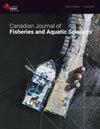Assessing small pelagic fish trends in space and time using piscivore stomach contents
IF 2.2
2区 农林科学
Q2 FISHERIES
Canadian Journal of Fisheries and Aquatic Sciences
Pub Date : 2023-10-04
DOI:10.1139/cjfas-2023-0093
引用次数: 0
Abstract
Changing distribution and abundance of small pelagic fishes may drive changes in predator distributions, affecting predator availability to fisheries and surveys. However, small pelagics are difficult to survey directly, so we developed a novel method of assessing the aggregate abundance of 21 small pelagic forage taxa via predator stomach contents. We used stomach contents collected from 22 piscivore species captured by multiple bottom trawl surveys within a Vector Autoregressive Spatio-Temporal (VAST) model to assess trends of small pelagics on the Northeast US shelf. The goal was to develop a spatial “forage index” to inform survey and/or fishery availability in the western North Atlantic bluefish (*Pomatomus saltatrix*) stock assessment. This spatially-resolved index compared favorably with more traditional design-based survey biomass indices for forage species well sampled by surveys. However, our stomach contents-based index better represented smaller unmanaged forage species that surveys are not designed to capture. The stomach-based forage index helped explain bluefish availability to the recreational fishery for stock assessment, and provided insight into pelagic forage trends throughout the regional ecosystem.利用鱼鱼胃内容物评估小型远洋鱼类在空间和时间上的趋势
小型远洋鱼类的分布和丰度的变化可能会导致捕食者分布的变化,影响渔业和调查的捕食者可用性。然而,对小型中上层动物进行直接调查是困难的,因此我们开发了一种新的方法,通过捕食者胃内容物来评估21种小型中上层动物饲料分类群的总丰度。利用矢量自回归时空(VAST)模型,利用多次底拖网调查收集的22种鱼科鱼类的胃内容物,评估了美国东北部陆架小型上层鱼类的变化趋势。目标是制定一个空间“饲料指数”,为北大西洋西部蓝鱼(*Pomatomus saltatrix*)种群评估的调查和/或渔业可用性提供信息。与传统的基于设计的调查生物量指数相比,该指数具有更好的空间分辨力。然而,我们基于胃内容物的指数更好地代表了调查不旨在捕获的较小的未管理的饲料物种。以胃为基础的饲料指数有助于解释休闲渔业对蓝鱼的可利用性,并为整个区域生态系统的中上层饲料趋势提供见解。
本文章由计算机程序翻译,如有差异,请以英文原文为准。
求助全文
约1分钟内获得全文
求助全文
来源期刊

Canadian Journal of Fisheries and Aquatic Sciences
农林科学-海洋与淡水生物学
CiteScore
4.60
自引率
12.50%
发文量
148
审稿时长
6-16 weeks
期刊介绍:
The Canadian Journal of Fisheries and Aquatic Sciences is the primary publishing vehicle for the multidisciplinary field of aquatic sciences. It publishes perspectives (syntheses, critiques, and re-evaluations), discussions (comments and replies), articles, and rapid communications, relating to current research on -omics, cells, organisms, populations, ecosystems, or processes that affect aquatic systems. The journal seeks to amplify, modify, question, or redirect accumulated knowledge in the field of fisheries and aquatic science.
 求助内容:
求助内容: 应助结果提醒方式:
应助结果提醒方式:


